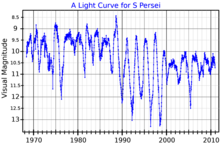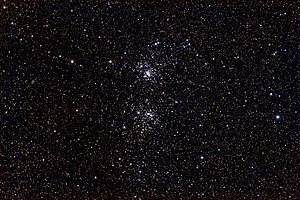S Persei
Location of S Persei (circled) near the Double Cluster (north is left) | |
| Observation data Epoch J2000 Equinox J2000 | |
|---|---|
| Constellation | Perseus |
| Right ascension | 2h 22m 51.70928s[1] |
| Declination | 58° 31′ 11.4476″[1] |
| Apparent magnitude (V) | +9.23[2] (7.9 - 12.0[3]) |
| Characteristics | |
| Spectral type | M3 Iae–M7[3] |
| B−V color index | +2.65[2] |
| Variable type | SRc[3]
|
| Absolute magnitude (MV) | –6.36 (at mV 9.23)[2] |
| Details | |
| Mass | 20[6] M☉ |
| Radius | 1,212[7] – 1,364[8] R☉ |
| Luminosity | 123,000[9] – 186,000[10] L☉ |
| Surface gravity (log g) | 0.0[11] cgs |
| Temperature | 3,500[12] (3,000[13] – 3,600[10]) K |
AAVSO 0215+58 | |
| Database references | |
| SIMBAD | data |
S Persei is a
Discovery
S Persei was named by German astronomer
Variability

S Persei varies slowly by several magnitudes, a factor of over 40 in brightness. It has a main period of somewhat over two years, but shows significant unpredictability. There is a strong variation in the amplitude from around one magnitude to about four magnitudes, and these have been interpreted as beats due to a second period of about 940 days.[16] Other analyses find only the primary period of 813 ± 60 days.[17]
S Persei is classified as a semiregular variable star of type SRc, indicating that it is a supergiant, and it has one of the largest visual amplitudes of any variable of this type.[3] While the General Catalogue of Variable Stars lists it as varying between magnitudes 7.9 and 12.0, it has since been seen fainter.[17]
The spectral type of S Persei also varies. Typically it is a red supergiant of spectral class M3 or M4, but particularly at deep visual minima it may show a much cooler spectral type of M7 or M8, highly unusual for a supergiant.[18]
Properties
Many of the visually bright variable stars belong to this class of semiregulars, as these stars are extremely large and luminous, and hence visible across long distances. S Persei has been described as a hypergiant[19] and has a radius over 700 times the sun's radius (R☉).[2] Its angular diameter has been measured directly and found to be somewhat elliptical. Modelled as a uniform disk, the radius corresponds to 1,212 ± 124 R☉.[7]
The temperature has been calculated from the spectrum using a DUSTY model,[20] giving an effective photospheric temperature of 3,500 K and a temperature of 1,000 K for the surrounding dust torus.[12] This is consistent with previous studies, but the derived luminosity from different authors varies from 86,000 L☉ to 186,000 L☉.[10][21][22] Older studies frequently calculated higher luminosities, lower temperatures, and consequently larger values for the radius.[23]
The mass of S Persei is also uncertain, but expected to be around 20 M☉.[6] Mass is being lost at 2.4 to 2.6×10−5 M☉ per year,[12] leading to an extensive and complex circumstellar environment of gas and dust.[10]
Location
S Persei is surrounded by clouds containing water molecules which produce
S Persei is a double star. The red supergiant has an A0 11th magnitude companion at 69".[25] There are also several other 8th to 10th magnitude stars within half a degree of S Persei.[26]
References
- ^ S2CID 18759600.
- ^ S2CID 15109583.
- ^ S2CID 16299532.
- S2CID 17804304.
- ^ S2CID 119183897.
- ^ .
- ^ Bibcode:2003AAS...203.4907T.
- ^ Norris, Ryan P. (2019). Seeing Stars Like Never Before: A Long-term Interferometric Imaging Survey of Red Supergiants (PDF) (PhD). Georgia State University.
- S2CID 210714093.
- ^ S2CID 53393926.
- doi:10.1086/301319.
- ^ S2CID 73650032.
- S2CID 16016698.
- .
- ^ "Download Data". aavso.org. AAVSO. Retrieved 1 October 2021.
- Bibcode:1974JAVSO...3...20S.
- ^ S2CID 5203133.
- Bibcode:2009ASPC..412..113W.
- S2CID 55509287.
- arXiv:astro-ph/9910475.
- S2CID 119276502.
- S2CID 18383796.
- Bibcode:1988A&AS...72..259D.
- .
- Bibcode:1994CoORB.115....1D.
- Bibcode:1994IBVS.4054....1S.

